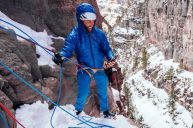A mountain climbing expedition turned to tragedy after a 21-year-old woman fell 500 feet to her death. Meanwhile, her friend just barely managed to avoid a similar fate. He saved himself at the last moment by grabbing onto a rock for dear life.
The incident happened at the Caminito del Rey pathway on Friday. The unidentified woman and her friend both took a plunge to certain death, but her friend managed to grab a rock as he plummeted. It's a split-second decision that saved his life. But sadly there's nothing he could do to save the 21-year-old woman from her own fatal plunge.
The two were at the Swiss Sector when the accident happened. They had spent the day practicing rock climbing, but they ended up making a mistake while scaling down the rock face. They went to the wrong route and ended up losing their balance upon the descent. That took them off the edge of a ravine. From the sound of it, it appears the two were free-climbing when the incident happened. Otherwise, they should have been harnessed.
21-Year-Old Falls To Her Death
Either way, mountain climbing carries inherent risks, especially if you're trying to scale somewhere new. Sadly, this 21-year-old woman found that out the hard way. Ultimately, she paid for it with her life. But if you're planning to try out the sport, practice caution.
The American Alpine Club has some important literature on risk assessment in the field.
They write, "Risk happens when climbers expose themselves to hazards, which introduces a variety of human factors into the risk cycle. This can alter predicted probabilities, create consequences where none previously existed, and negate mitigation tactics. To accurately understand risk, we need to understand how prone to error we can be. For example, we all know what it feels like to climb challenging fifth-class terrain. If the route is very difficult for us, falls are likely."
They continue, "If all of our mitigation techniques are effective (the equipment, the anchor and protection, the belay) we can confidently accept those risks. But humans are fallible. We forget a key step; we overlook important details; we miscommunicate. If a single human factor has compromised a climber's mitigation techniques, the most benign top-rope outing can shift into a high-consequence event. On the other side of the spectrum, a similar miscalculation happens when our dread of severe and deadly outcomes causes us to overestimate the likelihood of a high-consequence event."




